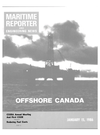
Page 30: of Maritime Reporter Magazine (January 15, 1986)
Read this page in Pdf, Flash or Html5 edition of January 15, 1986 Maritime Reporter Magazine
Demag Cranes Make Superlift
At Canadian Vito Shipyard
The Vito Steel Boat & Barge Construction shipyard in Canada recently delivered a 230-foot auxiliary navigation and supply vessel to the
Canadian Coast Guard. Economy considerations prompted the company to use a new approach to the assembly of the vessel. The complete super- structure, including the deck, was pre-assem- bled on the ground.
The shipyard used two Demag TC 2000 truck- mounted cranes (photo) to place the 500-ton superstructure onto the 35-foot-high hull. They first lifted the heavy load off the ground, rolled the hull under the superstructure, then did the precision lowering of the superstructure and joining of the assemblies. This method permit- ted the construction time to be reduced dramat- ically.
For further information on Demag cranes,
Circle 55 on Reader Service Card
For further information on Vito Steel Boat,
Circle 56 on Reader Service Card
EASTERN PRECISION CASTING INC.
MONTREAL, QUEBEC
Ferrous and Non-Fer- rous PRECISION
INVESTMENT
CASTINGS
Capabilities: Ferrous 20"x20"x20" and up to 150 lbs
Non-Ferrous 50"x30"x20"
In Canada: 820 Deslauriers
Montreal, Quebec H4N 1X1
Tel: 1-514-337-9600
In The U.S.A.:
P.O. Box 1844
Pittsburgh, NY 12901
Tel: 1-518-561-3124
Circle 124 on Reader Service Card
YDRAULICS
MANUFACTURER
SERVICE
REPAIR PARTS
CMH HELESHAW, INC. 201 HARRISON STREET
HOBOKEN, NEW JERSEY 07030
NEW YORK: (212) 267 0328
HOBOKEN: (201) 792-0500
TWX: 710-730-5224 CMH HBKN
STRETCHING ITS 607-FOOT LEGS—A massive offshore jackup drilling rig, the Rowan
Gorilla III, towers 437 feet above the surface of the water after its three steel legs had been extended an additional 100 feet. With its 607- foot tall legs, the Gorilla III is capable of drilling in water 450-feet deep in the Gulf of Mexico.
The leg extension project was recently per- formed in an outfitting basin near Pascagoula,
Miss., by 80 workers from Marathon LeTour- neau's Vicksburg, Miss, rig yard.
American Metal Bearing's
Rubber Bearing Staves Approved
By Navy—Literature Offered
Circle 302 on Reader Service Card
Large ship's propeller-shaft bearing with American Metal
Bearing's all-rubber staves lining the inner surface.
All-rubber bearing staves designed and pro- duced by American Metal Bearing Co. of Gar- den Grove, Calif., have been approved for use on
U.S. Navy ships to replace other rubber and brass staves supporting propeller shafts.
The approval was announced by Peter A.
Pagan, vice president and director of market- ing for the 64-year-old marine equipment manu- facturer.
AMB's staves will fit bearings with propeller shaft diameters of 6 to 36 inches. Grooves between the staves allow water to be channeled through the bearing for lubrication and to carry away sand and other abrasives.
American Metal Bearing's all-rubber staves utilize dual-hardness, low-friction nitrile rub- ber. The bearing surface is tough, but resilient, allowing abrasive particles to depress it rather than penetrating the bearing surface. This rub- ber is bonded to an even harder rubber backing, which takes the place of brass.
According to Mr. Pagan, the all-rubber stave has several advantages over older style staves, including: the hard rubber backing will not sep- arate from the softer rubber bearing surface; easier to install; it weighs less; and cost savings.
The company's primary business is the de- sign, manufacture, and repair of individual bear- ings and complete bearing systems for naval and commercial vessels, as well as a variety of uses in cement, petrochemical, rubber, steel, utilities, and heavy machinery industries.
For a copy of a brochure and complete litera- ture on American Metal Bearirig Company's all- rubber bearing staves,
Circle 57 on Reader Service Card
Mitsui Launches First
Of Six Containerships
For Lykes Bros. Steamship 32
The motor vessel Doctor Lykes, the first of six new 3,010-TEU Pacific Class containerships be- ing contructed for Lykes Bros. Steamship Co.,
Inc., New Orleans, La., in Japan, was recently launched at the Tamano City works of Mitsui
Engineering and Shipbuilding Co., Ltd.
The Pacific Class vessel, scheduled to enter
Lykes' trans-Pacific service in April, is 850 feet long, 106 feet wide, with an operating draft of 33 feet 8 inches.
Brochure Explains New USCG
Survival Suit Regulations
Survival International, Inc. has produced a new brochure that fully explains current U.S.
Coast Guard regulations concerning use of sur- vival suits.
Unlike some federal regulations published in the "Federal Register," this booklet is written in laymen terms—easy-to-understand language— and fully explains previous regulations and new laws inacted in December 1985 concerning who must carry survival suits aboard their vessels and why.
For example: Did you know the latest regula- tions require that your vessel carry two survival suits aboard for most crew members? Did you know that the latitude has been changed from 35 degrees to 32 degrees, meaning that if your vessel operates in these waters it must have sur- vival suits on board.
Do you know if your vessels are required to carry such safety equipment? What type of sur- vival suits are allowed under the law? Can you replace PFDs with survival suits?
These and many more questions are answered in this highly informative booklet. For your free copy,
Circle 53 on Reader Service Card
Maritime Reporter/Engineering News

 29
29

 31
31
